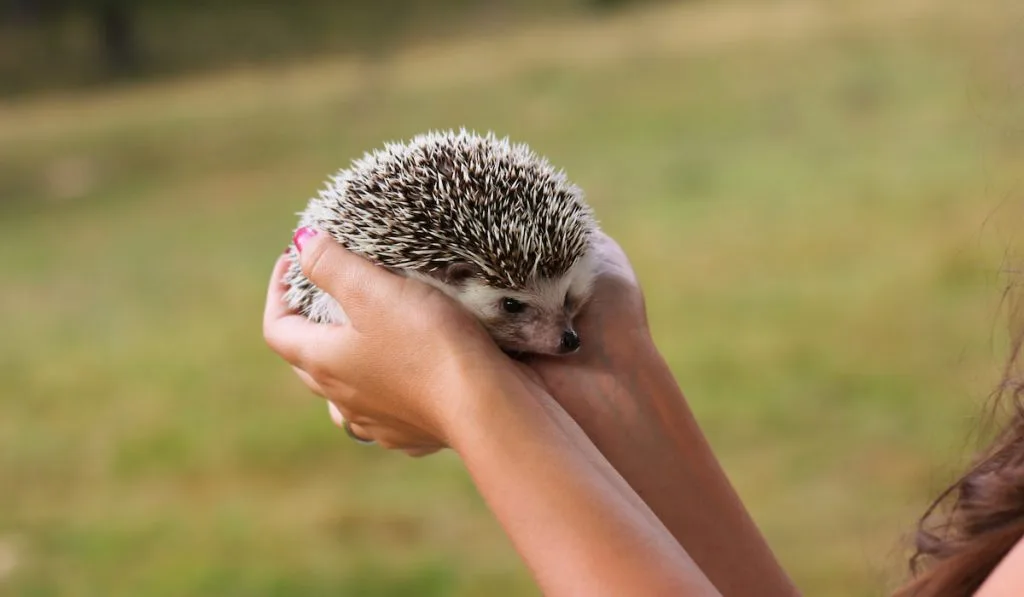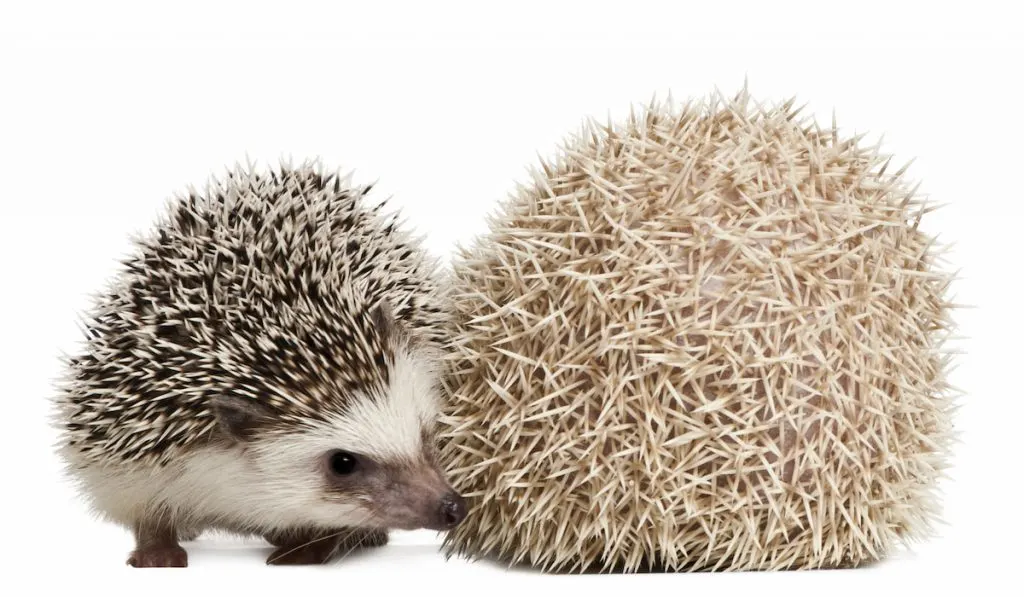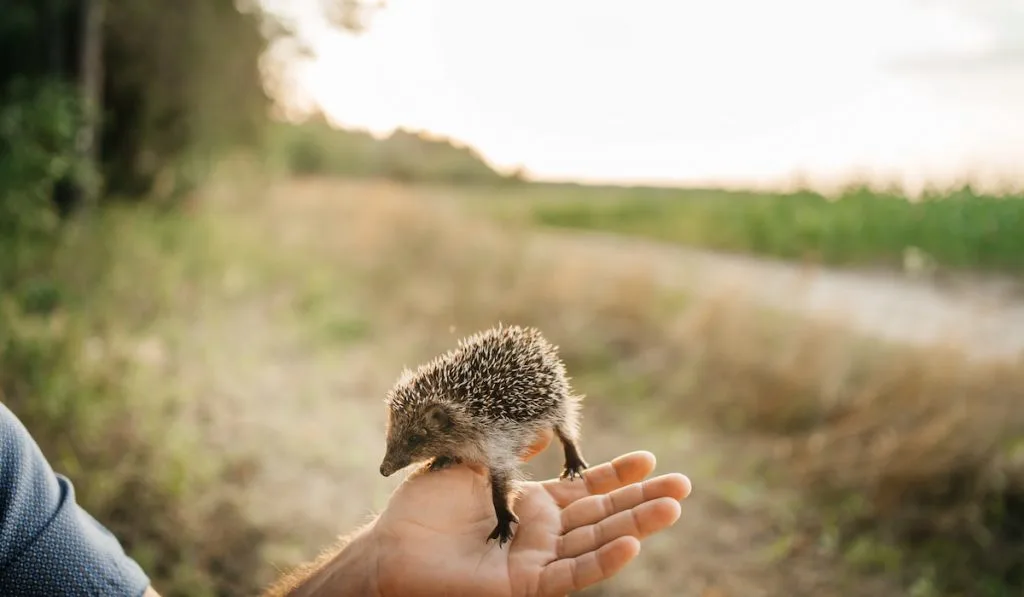Hedgehogs are definitely one of the internet’s favorite animals and many people enjoy keeping them as pets.
These spikey mammals are really cute, but before you consider getting one, definitely spend some time learning more about them so you can know how to treat them best.
For example, they have sharp spines to defend themselves from predators.
Does that mean the animal can hurt you too? It’s not all black and white so let’s find out more!

A Little Bit About Hedgehogs
This animal got its name because of its specific foraging methods.
It roots through hedges or some other undergrowth while looking for smaller creatures living there, such as centipedes, insects, worms, frogs, snakes, snails, or mice.
While doing that, you can hear the animal emitting grunts that sound like a pig (hog).
These adorable creatures are nocturnal; they are quite active during the night and sleep throughout the day.
However, in cold climates, they will sleep a bit longer since that’s when they hibernate. They’re active the entire year in a temperate climate.
While hunting, they mostly rely on hearing and smell, since their eyesight is really not that good.
A group of hedgehogs is called an “array.” But you’ll rarely see an array since they are solitary animals who come together only when it’s mating time.
In most cases, they’re immune to snake venom, which is why snakes can easily end up as their main meal – with insects and berries as a side dish.

What About Their Quills?
Their undersides are rather soft, so the back and sides are the main areas for their defense mechanism.
Hedgehogs have around 7,000 individual quills, and muscles along their backs raise and lower the quills in response to potentially dangerous situations.
Unlike porcupines, hedgehogs do not have barbed spikes – and they are not poisonous, either.
Their quills are actually spines or a kind of modified hair mostly hollow on the inside; they consist of an array of complex air chambers that make them lightweight, but still strong enough for defense.
Back muscles where their quills sit allow the animal to curl into a ball when necessary.
In such a state, the hedgehog extends its spines to repel and defend against potential threats.
What happens is that the hedgehog’s body shifts the weight distribution of its spines. So, the back muscles move, and, by that, spines spread out making a sharp surface.
They’re usually not strong enough to pierce your skin, but they can still be painful.

Can a Hedgehog Actually Hurt You?
When they’re curled up into a spiky ball, it means they’re afraid and feel threatened.
When this is the case, yes, they can hurt you, so it’s not recommended to touch them. Perhaps you can wait for a while until the animal calms down and goes back to a more relaxed state.
Aside from that, hedgehogs are really dangerous. If you want to pet one, don’t do it in the opposite direction quills grow.
It’s not just their spikes – they bite too!
This usually happens when the animal is going through potential stress, especially while handling unnatural situations in a domesticated setting. It’s possible it’s going through some physical discomforts or feels ill.
Over time, you’ll learn to recognize the reason for that bite. Although it doesn’t happen often, it could hurt a little.

How Can You Handle a Hedgehog So It Doesn’t Hurt You?
People that haven’t faced this specific animal are sometimes afraid of getting hurt when handling it.
In reality, there’s really not much to fear if you do it the right way. First of all, check if the animal feels calm in your presence.
When they are relaxed, their quills are not in the same position as they are when they feel threatened.
They’re not pointed upwards so you can pet this adorable creature, without even feeling how sharp its quills are.
They go towards the rear, so keep in mind to pet them in the that direction. Going in the opposite direction increases the chances for you to get hurt.
However, there are situations when you don’t have time to wait for the animal to get relaxed again and simply need to move it from one place to another, even if it’s curled up into a ball.
It’s always to better wait until the animal calms and realizes there’s nothing dangerous or threatening surrounding it, of course.
Still, if you don’t have enough time, you can take an extra thick towel or blanket, together with protective gloves.
You want your hedgehog to stay safe, so, after you move it, check to make sure its quills are free from the fabric.

Some Final Words
Hedgehogs are peaceful animals with no intentions to hurt you. When they’re relaxed, you can pet them since their quills won’t be sharp.
When they’re scared, no matter what the reason is, the best you can do is to wait for them to calm down or eventually remove something they find threatening.
You won’t get really hurt even if you touch the hedgehog in such a situation, but it may still be better to avoid it.
When it comes to biting, don’t consider it an aggressive trait. In most cases, there’s a message this little cutie wants to send you – and it’s the only way it can communicate it.
Maybe that could be pain, emotional distress, discomfort, or illness. Either way, you’ll learn to recognize it over time.
Resources:
- https://www.mentalfloss.com/article/56004/16-fun-facts-about-hedgehogs
- https://vetmed.illinois.edu/pet_column/hedgehog-pets
- http://hedgehogkeeper.com/can-hedgehogs-hurt-you/#What_can_make_hedgehogs_dangerous
- https://www.nationalgeographic.com/animals/mammals/facts/hedgehog
- https://www.hedgehogworld.com/why-do-hedgehogs-bite/
